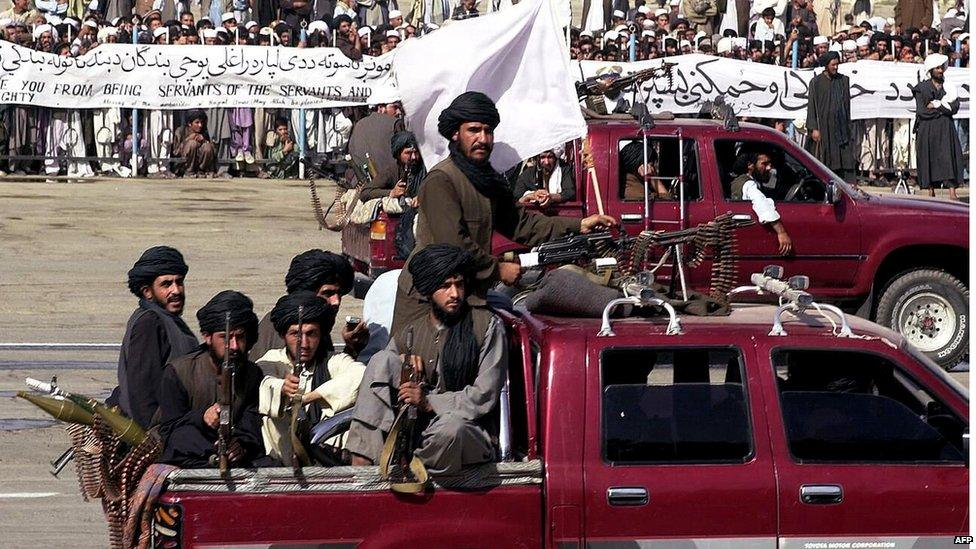Obituary: Mullah Omar, reclusive figure
- Published

The Taliban leader is believed to have suffered a shrapnel wound to his right eye in the 1980s
Mullah Omar was a reclusive figure even before his Taliban government fell from power in late 2001 and he was forced into hiding.
He left virtually all contact with the outside world to his foreign minister, Wakil Ahmad Mutawakkil and the last known audio recording of him was in 2006 - even this was leaked and not meant for public consumption.
Yet he remained a powerful figure in Afghanistan, the undisputed leader of the Taliban and dubbed "commander of the faithful", a title with great resonance in Islamic history.
On 29 July 2015 the Afghan government announced that he had died in a hospital in Karachi, Pakistan in April 2013. No more details were provided.
He was replaced as Taliban leader by Mullah Akhtar Mansour the following day.
According to a biography published by the Taliban in April 2015, Mullah Mohammed Omar was born in 1960 in the village of Chah-i-Himmat, in the Khakrez district of Kandahar province, in the south of the country.
It is thought he later attended the Darul Uloom Haqqania, a madrassa in Pakistan.
This Islamic seminary has been dubbed "the University of Jihad" and boasted a number of future radical leaders among its students.
Mullah Omar abandoned his studies to join the forces resisting the the Soviet occupation in 1980s but only rose to the level of small-time commander.
He never did any practical field commanding during the Taliban's 1994-96 campaign that culminated in their capture of Kabul.
But the localised uprising that he led against former Mujahideen warlords in the Kandahar area in 1994 earned him wide respect and is regarded by some as a catalyst for the Taliban movement that followed.
He was wounded a number of times during this period, including an eye injury caused by shrapnel.
It was after the capture of Kabul that he was elected the movement's supreme leader.
Islamic law
During this period Omar began his long association with the al-Qaeda leader Osama Bin Laden.
Mullah Omar vigorously defended his friend against allegations that he masterminded the devastating attacks on the World Trade Center and the Pentagon, accusing the US of trying to cover up their own intelligence failures.

Mullah Omar's Taliban government fell from power in 2001
Bin Laden is believed to have at least partially financed the Taliban takeover of Afghanistan.
The ties may go further. It was thought that Mullah Omar had taken Bin Laden's eldest daughter as a wife, and that Bin Laden may even have taken one of Mullah Omar's daughters as a fourth wife.
The two were reported to have spoken daily by satellite telephone, and some reports suggested they also met for fishing trips.
Under Mullah Omar's rule, a strict interpretation of Islamic law was imposed on Afghanistan under Taliban control.
US invasion
Women were strongly discouraged from leaving their homes, denied schooling and jobs and forced to fully cover themselves.
Women found guilty of adultery were stoned to death, homosexuals crushed under brick walls, thieves' hands amputated and murderers publicly executed by victims' families.
Edicts from Mullah Omar included the death sentence for anyone converting to another religion, as well as the infamous orders to destroy the country's ancient Buddha statues at Bamiyan.
It was Mullah Omar's backing for Osama Bin Laden that brought the US-led campaign to oust the Taliban.

Mullah Omar was often represented by his foreign minister, Wakil Ahmed Muttawakil, seen here in May 2001, with UN refugee agency chief Ruud Lubbers
Omar and most of the other senior Taliban leaders, along with Bin Laden and some of his al-Qaeda associates, survived the American onslaught.
A message emailed to journalists in 2009 and attributed to Mullah Omar, urged Taliban members to continue to fight against foreign military forces in Afghanistan.
Despite one of the largest manhunts in the world, he managed to evade capture. Some believed that he was actually taking refuge in Pakistan although this was strongly denied by officials in Islamabad who claimed he was still in Afghanistan.
However, the arrest of the Taliban's second-in-command, Mullah Abdul Ghani Baradar, near Karachi in January 2010 lent credence to the idea that other top Afghan Taliban leaders were in hiding in Pakistan.
This suspicion was reinforced in May 2011 when American special forces killed Osama Bin Laden in his secure compound in the Pakistani garrison city of Abbottabad.
Later that month a rumour circulated that Omar had been killed by the Pakistani intelligence services although the Taliban insisted he was still alive and living in Afghanistan.
The April 2015 biography claimed Omar was still alive, stating that he was keenly following "the jihadi activities against the brutal infidel foreign invaders", adding: "He remains in touch with the day-to-day happenings of his country as well as the outside world."
The biography also described him as "affable", adding he had "a special sense of humour and never considers himself superior to his colleagues".
A statement purporting to be from him in July 2015 backed peace talks with the Afghan government, saying Islam did not bar "peaceful interaction" with enemies.